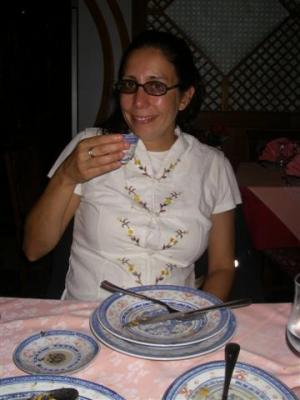Continued from yesterday… Then we hopped on the subway and went back to the Vatican, this time to see St. Peter’s Basilica. As we walked around the Vatican walls towards St. Peter’s, we noticed a white line painted in the street paralleling the walls. We think that is the border. We passed by the entrance into Vatican City, guarded by two real Swiss guards. Their uniforms are silky looking, with big ballooning arms and legs that get tight at the forearms and calves. The legs extend all the way to the feet, with little black shoes. They are red, yellow and dark blue striped, with big, frilly, white collars. They have big helmets with red feathers sticking out of the top. And they do hold a vicious looking medieval weapon similar to the ones we saw in the museum in Malta
We don’t know why, but for some reason we didn’t think you are allowed to go into the inner city portion of Vatican City. People seemed to be coming and going freely, and Christi wanted to go in and have a look, but Eric was sure the guards wouldn’t let us in. He thinks the people going in were people who were familiar to the guards, which is why they weren’t stopped. So we didn’t try and continued on to St. Peter’s.
This site used to house a stadium called Ager Vaticanus. It is believed that Jesus’ apostle, Peter, was martyred in and buried under the stadium. So Emperor Constantine tore down the stadium and built a basilica on the site in honor of St. Peter. The church was completed in 326 AD. By the early 1500’s it had fallen into serious disrepair, so they started a “remodel”. They redesigned the floor plan and tore down the majority of the old church. There was a lot of criticism about the needless destruction of the beautiful works of art that had been inside the basilica. It took 150 years to complete the new basilica, and some of the greatest artists, including as Raphael, Bernini and Michelangelo, contributed to the artwork and design.
St. Peter’s Basilica is currently the second largest church in the world at 187 meters (roughly 550 feet) long and 119 meters (approx 350 feet) tall at the top of the biggest dome. It can hold 60,000 people. It was originally designed to be shaped like a Greek cross (all 4 sides equal length) then was switched to be a Latin cross (bottom side longer than the other three sides) in the late 1500’s. In front of the church is St. Peter’s square, the largest piazza (town square) in Rome at 240 meters wide and 340 meters long (approx 720 feet by 100 feet). It was designed by Bernini in the 1600’s as a place for Christians to gather. Thousands upon thousands of people flock to the square to hear the pope speak.
The square is really an oval. The west and east side (long sides) of the oval are open. The east side is the basilica entrance, the west side gives you a clear view of the whole front of the basilica. The north and south sides each have a beautiful marble colonnade (covered walkway, also oval since it follows the edge of the “square”) with grandiose pillars that lead you to the north/south corner of the front of the basilica. The colonnade is topped with 140 gigantic statues of saints, evenly dispersed.
In the very center of the oval is an obelisk, taken from Egypt. Once again, this baffles us. The Christians made the Egyptians close their temples and end all of their ancient pagan religious traditions, including writing in hieroglyphics. Yet gracing the courtyard of the Vatican is an actual idol where people worshipped the banned pharaoh-gods. It is said the cross mounted to the top of the obelisk contains a piece of THE holy cross Jesus was crucified on. Halfway between the obelisk and the colonnade, on both sides, is a fountain. The two fountains match. It is all quite symmetrical. The first picture is taken from the northeast side of the courtyard, facing southwest. You can see the entrance to the southern colonnade to the left, and then see the curve of the colonnade in the background. If you look carefully, you can see the pillars and the statues on top. To the right is the obelisk. The second picture is of one of the fountains, with a pretty good shot of the statues on the colonnade in the background.
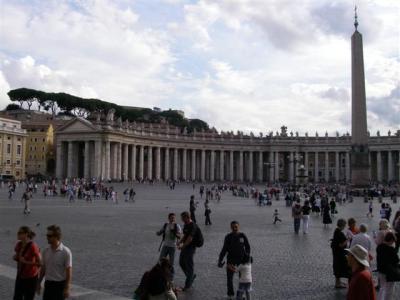
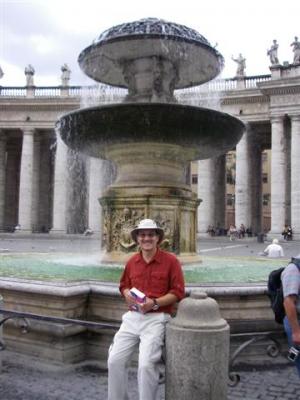
Here is the front of the basilica. The church is super tall. From the outside it looks like it would be three stories, with each story having the especially tall ceilings popular in that era, but it turns out it is just one level.
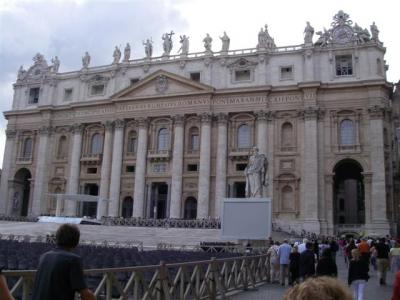
Inside and out the church is opulent, but tastefully done. The floors are colored marble in geometric designs. The walls are also mostly colored marble, with the colors tastefully complimenting one another. The domes are covered in ornate frescos. The rest of the ceiling is mostly carved geometric patterns trimmed in gold.
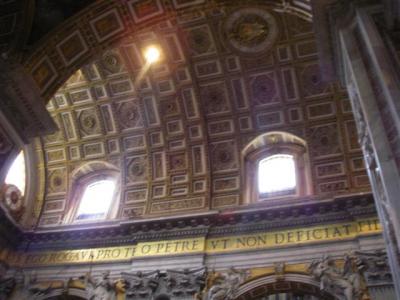
There are paintings and statues everywhere, but they are generally nicely disbursed so as not to be overwhelming. Most of it is beautiful, detailed, amazing pieces along the same lines we have seen in other baroque era churches. All the artwork is literally larger than life. To give you a sense of scale, tiny cherubs are the size of an average human, and humans are at least 10 feet tall.

Some of the paintings have clear coffins with the remains of dead popes underneath. They look like wax dummies. We wonder if they really are wax copies, with the real remains are lurking around nearby. We know nothing about embalming, but can they really preserve these old guys so well for so long? The whole concept of having dead bodies on display kind of grosses us out.
There are a few little alcove chapel areas off on the sides, where people were worshipping. We didn’t go into any of those, not wanting to disturb those in prayer.
There are several pieces of art within the main altar area at the front of the church, but the focal point is a big bronze sculpture. It is”¦ er”¦ interesting. The closest description we can give of it is it looks like a canopy bed on steroids. It has 4 really big, and we mean gigantic for a sculpture, twisting pillars. The top kind of looks like the frame of a tent, a square base where the sides all meet in one point at the top, except it is obviously thicker, more solid, and more decorative than a tent frame, hence the effect of being a fancy canopy. There are a few sculptures of people up there, too. It is almost 90 feet tall. Only the pope is allowed to use it.
There is a museum off to one side with lots of sacred relics and priceless artifacts. We tried to go into it, but the guard stopped us. He didn’t speak English, so we didn’t know why we were stopped. Maybe we should have tried again later to go inside, but we didn’t.
Entrance to the main part of the basilica is free. The museum we wanted to go to was $9 USD each. For $10.50 USD, you can go up to the top of the biggest dome, is supposed to have a nice view of Rome and stunning art by Michelangelo, but it is up a very long flight of stairs and we weren’t up for the climb. For $15.00 USD, you could go into the grottos under the church and look at the tombs of the popes, at least the ones not already on display in the church. Dead bodies aren’t our thing, so we decided to skip it. Below the grotto is the original necropolis that was under the stadium where you can see even older tombs, including St. Peter’s for an additional $15.00 USD. Even if we wanted to go, we probably couldn’t have because you have to book in advance.
It was now 1730, and we weren’t sure what to do. We found the day that we went to the Vatican Museums that the transit out to and inside the suburbs doesn’t run all that late, so we had to leave Rome no later than 2100. This made getting dinner in Rome a problem, since the restaurants open at 2000 and European style service means meals almost always take longer than an hour. We decided to head back.
We were back in the suburbs at 1900. Much to our joy, we found a Chinese restaurant open, run by genuine Chinese immigrants. Yay! We were hungry and were so glad we didn’t have to wait another hour. We found it funny that we wound up eating Chinese, since Christi happened to be wearing the top she got in Hong Kong, China.
